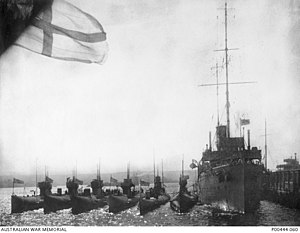 Six J-class subs next to their supply ship HMAS Platypus in 1919
| |
| Class overview | |
|---|---|
| Name | J class |
| Operators | |
| In commission | 1916–1930 |
| Planned | 8 |
| Completed | 7 |
| Cancelled | 1 |
| Lost | 1 |
| Scrapped | 6 |
| Preserved | 1 (J7 is extant as a breakwater) |
| General characteristics (original design) | |
| Type | Submarine |
| Displacement |
|
| Length | 274 ft (84 m) |
| Beam | 23 ft 1 in (7.04 m) |
| Draught | 14 ft (4.3 m) |
| Propulsion |
|
| Speed |
|
| Range | 91 tons Diesel Oil for5,000 nautical miles (9,000 km) at 12.5 knots (23 km/h) |
| Test depth | 300 feet (91 m) |
| Complement | 5 officers, 40 seamen |
| Armament |
|

The J-class submarines were seven submarines developed by the Royal Navy prior to the First World War in response to claims that Germany was developing submarines that were fast enough to operate alongside surface fleets. Six were completed during mid-1916, while a seventh entered service at the end of 1917.
Although larger and more powerful than previous British submarines, the J class could not keep up with surface vessels, and operated independently during the war. Between them, the submarines sank a U-boat, and heavily damaged two battleships, with the loss of HMS J6 to friendly shelling.
Following the war, the six surviving submarines were gifted to the Royal Australian Navy (RAN). All six were paid off during the 1920s. Two were scuttled as breakwaters in Port Phillip Bay, and four were scuttled in the ship graveyard off Port Phillip heads.